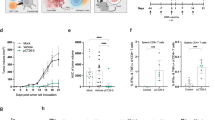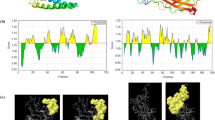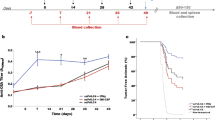Abstract
Genetic immunization against tumor antigens is an effective way to induce an immune response able to oppose cancer progression. Overexpression of HER-2/neu can lead to neoplastic transformation and has been found in many human primary breast cancers. We constructed DNA expression vectors encoding the full-length neu oncogene of rat cDNA (pCMV-NeuNT), the neu extracellular domain (pCMV-ECD), or the neu extracellular and transmembrane domains (pCMV-ECD-TM). We evaluated whether i.m. injection of these plasmids induces protection against the development of mammary tumors occurring spontaneously in FVB/N neu-transgenic mice. We found that pCMV-ECD-TM induced the best protection, whereas both pCMV-ECD and pCMV-NeuNT were less effective. The coinjection with a bicistronic vector for murine IL-12 increased the efficacy of pCMV-ECD and pCMV-NeuNT plasmids, and led to the same protection obtained with pCMV-ECD-TM alone. Anti-neuECD antibodies were detected in pCMV-ECD-TM vaccinated mice and, after coinjection with pCMV-IL12 plasmids, they appeared also in animals immunized with pCMV-ECD. Our data demonstrate the effectiveness of DNA vaccination using truncated Neu plasmids in inducing antitumor protection in a spontaneous mammary tumor model.
This is a preview of subscription content, access via your institution
Access options
Subscribe to this journal
Receive 12 print issues and online access
$259.00 per year
only $21.58 per issue
Buy this article
- Purchase on Springer Link
- Instant access to full article PDF
Prices may be subject to local taxes which are calculated during checkout



Similar content being viewed by others
References
Bargmann CI, Hung UC, Weinberg RA . The neu oncogenes encodes epidermal growth factor receptor-related protein Nature 1986 319: 226–230
Coussens L et al. Tyrosine kinase receptor with extensive homology to EGF receptor shares chromosomal location with neu oncogene Science 1985 230: 1132–1139
Bargmann CI, Hung UC, Weinberg RA . Multiple independent activation of the neu oncogene by a point mutation altering the transmembrane domain of p185 Cell 1986 45: 649–657
Bargmann CI, Weinberg RA . Oncogene activation of the neu-encoded receptor protein by point mutation and deletion EMBO J 1988 7: 2043–2052
King CR, Kraus MH, Aaronson SA . Amplification of a novel v-erbB related gene in human mammary carcinoma Science 1985 229: 974–976
Slamon DJ et al. Human breast cancer: correlation of relapse and survival with amplification of Her-2/neu oncogene Science 1987 235: 177–182
van de Vijver M et al. Amplification of the neu (c-erbB2) oncogene in human mammary tumors is relatively frequent and is often accompained by amplification of the linked c-erbA oncogene Mol Cell Biol 1987 7: 2019–2023
Berchuck A et al. Overexpression of HER-2/neu is associated with poor survival in advanced epithelial ovarian cancer Cancer Res 1990 50: 4087–4091
Kern JA et al. p185neu expression in human lung adenocarcinomas predicts shortened survival Cancer Res 1990 50: 5184–5191
Yonemura Y et al. Evaluation of immunoreactivity for erbB-2 protein as a marker of poor short term prognosis in gastric cancer Cancer Res 1991 151: 1034–1038
Slamon DJ et al. Studies of the HER-2/neu protooncogene in human breast and ovarian cancer Science 1989 244: 707–712
Allred D et al. Overexpression of HER-2/neu and its relationship with other prognostic factors change during the progression to in situ invasive breast cancer Hum Pathol 1992 23: 974–978
Disis ML et al. Existent T-cell and antibody immunity to HER-2/neu protein in patients with breast cancer Cancer Res 1994 54: 16–20
Disis ML et al. Peptide-based but not whole protein, vaccines elicit immunity to HER-2/neu, an oncogenic self-protein J Immunol 1996 156: 3151–3158
Amici A, Venanzi FM, Concetti A . Genetic immunization against neu/erbB2 transgenic breast cancer Cancer Immunol Immunother 1998 47: 183–190
Chen Y et al. DNA vaccines encoding full-length or truncated neu induce protective immunity against neu-expressing mammary tumors Cancer Res 1998 58: 1965–1971
Boon T, Coulie PG, Van den Eynde B . Tumor antigens recognized by T cells Immunol Today 1997 18: 267–268
Coulie PG . Human tumor antigens recognized by T cells: new perspectives for anticancer vaccines? Mol Med Today 1997 3: 261–268
Gerrard TL, Terz JJ, Kaplan AM . Cytotoxicity to tumor cells of monocytes from normal individuals and cancer patients Int J Cancer 1980 26: 585–593
Ziegler-Heithbrock HW et al. Tumor necrosis factor as effector molecule in monocyte mediated cytotoxicity Cancer Res 1986 46: 5947–5952
Gerrard TL, Cohen DJ, Kaplan AM . Human neutrophil-mediated cytotoxicity to tumor cells J Natl Cancer Inst 1981 66: 483–488
Colombo MP et al. Amount of interleukin-12 available at the tumor site is critical for tumor progression Cancer Res 1996 56: 2531–2534
Kim JJ et al. In vivo engineering of a cellular immune response by coadministration of IL-12 expression vector with a DNA immunogen J Immunol 1997 158: 816–826
Concetti A et al. Autoantibody to p185 oncoprotein by vaccination with xenogenic DNA Cancer Immunol Immunother 1996 43: 307–315
Acknowledgements
This work was supported by Associazone Italiana per la Ricerca sul Cancro (AIRC) and by INDENA SpA, Milano. We thank Professor G Forni of the Department of Clinical and Biological Sciences, University of Torino, Dr E Balducci of the Department of Morphological Sciences and Comparative Biochemistry, University of Camerino and Dr R Salvi of the CHUV-Nestlé of Lausanne for their helpful discussions.
Author information
Authors and Affiliations
Rights and permissions
About this article
Cite this article
Amici, A., Smorlesi, A., Noce, G. et al. DNA vaccination with full-length or truncated Neu induces protective immunity against the development of spontaneous mammary tumors in HER-2/neu transgenic mice. Gene Ther 7, 703–706 (2000). https://doi.org/10.1038/sj.gt.3301151
Received:
Accepted:
Published:
Issue Date:
DOI: https://doi.org/10.1038/sj.gt.3301151
Keywords
This article is cited by
-
Booster immunizations with DNA plasmids encoding HER-2/neu prevent spontaneous mammary cancer in HER-2/neu transgenic mice over life span
Scientific Reports (2017)
-
Antibody response to HER2 extracellular domain and subdomains in mouse following DNA immunization
Tumor Biology (2016)
-
In vivo electroporation restores the low effectiveness of DNA vaccination against HER-2/neu in aging
Cancer Immunology, Immunotherapy (2012)



